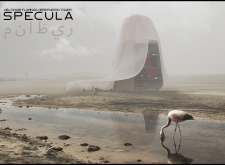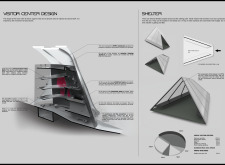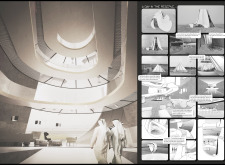5 key facts about this project
SPECULA is designed primarily as an observation tower, providing visitors with an elevated perspective of the wetland landscape, making it an ideal point for birdwatching and nature appreciation. The tower's architecture emphasizes accessibility, allowing visitors of all ages and abilities to experience the rich biodiversity of the wetlands through carefully designed observation platforms and visitor facilities. Each element of the design is deliberately arranged to facilitate an engaging and immersive experience in the natural surroundings, drawing attention to the importance of conservation and ecological awareness.
A standout feature of the project is its fluid and organic design, inspired by the undulating forms of sand dunes in the region. The tower's graceful curves not only enhance its aesthetic appeal but also contribute to its harmonious integration with the landscape. The exterior is wrapped in a lightweight ETFE (Ethylene Tetrafluoroethylene) membrane, which serves multiple functions: it allows natural light to fill the interiors while providing shelter from the elements and minimizing energy consumption. This approach illustrates a commitment to sustainability within architectural design, emphasizing the importance of environmental consciousness in modern buildings.
Within the structure, several key components cater to different visitor needs and enhance the overall experience. The visitor center serves as an educational hub, showcasing the ecological significance of the Al Wathba Wetland. Here, visitors can learn about local flora and fauna and gain insights into the region's conservation efforts. Observation decks are strategically placed at varying heights, granting visitors immersive views of the wetlands and allowing them to witness the vibrant bird life close-up. The thoughtful inclusion of these platforms ensures that engagement with nature is maximized, underscoring the tower's primary purpose.
Additionally, the project includes comfortable spaces such as cafés and souvenir shops, which allow for social interaction and provide visitors with the opportunity to relax after exploring the wetlands. These amenities contribute to a comprehensive visitor experience, emphasizing that architecture can foster community and ecological education.
The unique design approaches seen in SPECULA extend beyond its aesthetic considerations to encompass functional aspects that encourage interaction with nature. The internal circulation routes guide visitors through the building while offering various vantage points for observation. Ramps connect different levels, promoting a fluid movement that reflects the natural flow of the surrounding landscape. This design philosophy not only enhances accessibility but also aligns with the overarching aim of creating a seamless bond between the built environment and the natural world.
Furthermore, the use of natural materials such as wood within the interior areas adds warmth and invites visitors to engage more intimately with the space. The thoughtful material selection reinforces the architectural narrative of sustainability and ecological sensitivity, creating a space that is inviting and harmonious.
The Abu Dhabi Flamingo Observation Tower exemplifies modern architectural practices that prioritize environmental engagement and educational outreach. As such, it serves as a model for future developments in ecologically sensitive areas, showcasing how thoughtful design can foster a deeper connection between people and nature. For those interested in exploring this project further, detailed architectural plans, sections, and design concepts are available, offering an in-depth look at how the architectural ideas manifest in this exciting design. Delve deeper into the presentation to fully appreciate the architectural nuances and thoughtful considerations that define SPECULA.


























